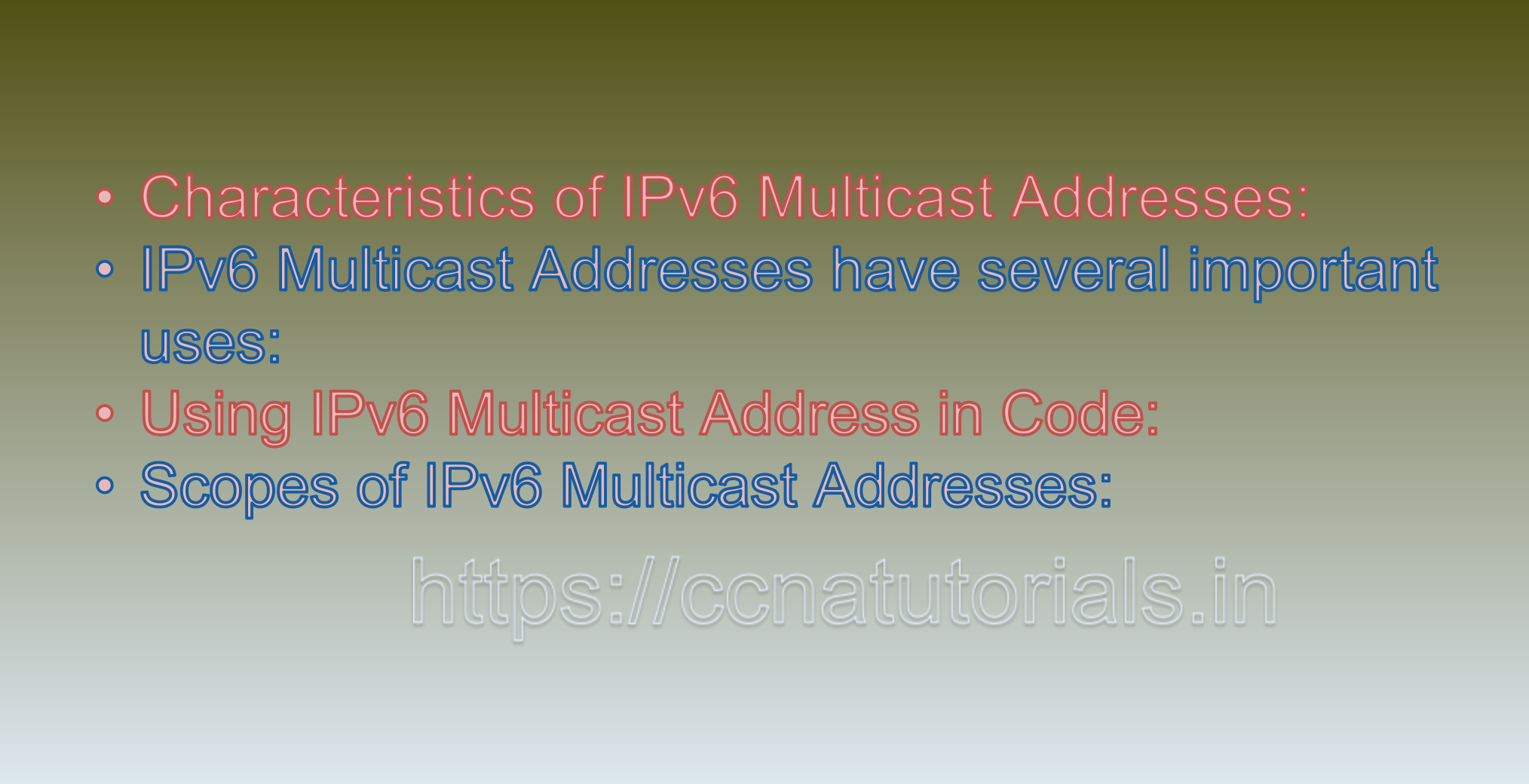Contents of this article
In this article, I describe IPv6 Multicast Addresses. IPv6 Multicast Address are a type of IPv6 address used to facilitate efficient one-to-many or many-to-many communication in IPv6 networks. Unlike unicast addresses that identify individual devices and enable point-to-point communication, multicast addresses allow a single sender to reach multiple recipients simultaneously. In this guide, we’ll explore the concept of IPv6 Multicast Address, their structure, characteristics, uses, and examples.
Characteristics of IPv6 Multicast Addresses:
1. One-to-Many Communication:
IPv6 Multicast Address enable one-to-many or many-to-many communication, where a single sender can send packets to a group of recipients.
2. Address Range:
IPv6 Multicast Address are assigned a specific address range `ff00::/8`. The first octet of a multicast address starts with `1111 1111` (binary) or `FF` (hexadecimal).
3. Scope Identifier:
Multicast addresses include a scope identifier that defines the scope of the multicast group. Scopes indicate the reach of the multicast traffic and control where the packets are delivered.
4. Reserved and Well-Known Addresses:
Some multicast addresses are reserved for specific purposes, such as all-nodes multicast (`ff02::1`) and all-routers multicast (`ff02::2`).
Multicast Address Scopes:
IPv6 multicast addresses are categorized into different scopes, which determine the reach of the multicast traffic:
1. Interface-Local Scope (`ff01::/16`):
Limited to the local network segment (link) and not forwarded beyond the interface.
2. Link-Local Scope (`ff02::/16`):
Limited to the local network segment (link) and can be forwarded within the same link.
3. Realm-Local Scope (`ff03::/16`):
Limited to a specific realm (organization or site) and is typically not forwarded beyond the realm.
4. Admin-Local Scope (`ff04::/16`):
Limited to a specific administrative domain and is typically not forwarded beyond that domain.
5. Site-Local Scope (`ff05::/16`):
Limited to a specific site within an organization.
6. Organization-Local Scope (`ff08::/16`):
Limited to the organization and may span multiple sites.
7. Global Scope (`ff0e::/16`):
Intended for global use and can traverse the entire IPv6 network.
Uses of IPv6 Multicast Address:
IPv6 Multicast Address have several important uses:
1. Efficient Group Communication:
Multicast addresses enable efficient one-to-many or many-to-many communication, reducing network traffic and conserving resources.
2. Multimedia Streaming:
Multicast is often used for multimedia streaming, where a single sender can reach multiple recipients simultaneously.
3. Network Management:
Multicast addresses are used for network management tasks, such as router discovery, time synchronization, and service discovery.
4. IPv6 Neighbor Discovery:
Multicast address are used in IPv6 Neighbor Discovery to reach multiple devices on a link.
Example of IPv6 Multicast Address:
Let’s consider the example of the all-nodes multicast address (`ff02::1`), which is used to communicate with all IPv6-enabled nodes on the local network segment (link).
Address: `ff02::1`
Scope: Link-Local Scope (`ff02::/16`)
Description: Used to reach all nodes on the same link for various purposes, including neighbor discovery and network management.
Using IPv6 Multicast Address in Code:
Here’s an example of using an IPv6 multicast address in Python’s socket programming:
python
import socket
multicast_group = ‘ff02::1’ # All-Nodes Multicast Address
port = 12345
sock = socket.socket(socket.AF_INET6, socket.SOCK_DGRAM)
sock.bind((‘eth0’, port))
# Join the multicast group
sock.setsockopt(socket.IPPROTO_IPV6, socket.IPV6_JOIN_GROUP, socket.inet_pton(socket.AF_INET6, multicast_group))
# Send multicast data
message = b’Hello, multicast world!’
sock.sendto(message, (multicast_group, port))
Conclusion for this portion related to IPv6 Multicast Addresses:
IPv6 Multicast Addresses play a crucial role in enabling efficient one-to-many or many-to-many communication within IPv6 networks. They are used for multimedia streaming, network management, and other scenarios where reaching multiple recipients simultaneously is essential. By understanding the structure, scopes, and characteristics of Multicast Address, network administrators can design and implement IPv6 networks that support effective and optimized group communication.

IPv6 Multicast Addresses via another approach
IPv6 Multicast Addresses are a special type of IPv6 address used to support one-to-many communication within an IPv6 network. Multicast communication allows a single source to send data to a group of interested recipients, making it an efficient way to distribute information to multiple devices simultaneously. In this guide, we’ll delve into the concept of IPv6 Multicast Addresses, their structure, characteristics, and examples.
Characteristics of IPv6 Multicast Addresses:
1. Group Communication:
IPv6 Multicast Addresses are designed for one-to-many communication. A single sender can transmit data to a multicast group, and multiple devices can receive the data if they are part of that group.
2. Address Range:
IPv6 Multicast Addresses are identified by a specific address prefix. They fall within the range `ff00::/8`, where the first 8 bits are set to `11111111`.
3. Scope:
Multicast Addresses include a scope field that defines the intended scope of the multicast group, such as link-local, site-local, or global.
4. Flags:
Multicast Addresses also include flags that provide additional information about the multicast group, such as whether the group is well-known or transient.
5. Well-Known Addresses:
Some Multicast Addresses are reserved for specific purposes and are known as well-known addresses. They are predefined for various functions, such as router discovery or all-nodes communication.
6. Scope Identifier:
A scope identifier can be appended to the multicast address using a percent sign (%) to indicate the desired scope, such as `%eth0` for the local link.
Uses of IPv6 Multicast Addresses:
IPv6 Multicast Addresses serve several important purposes in an IPv6 network:
1. Efficient Communication:
Multicast communication optimizes network resources by enabling data to be sent once and received by multiple devices interested in that data.
2. Group Messaging:
Multicast Addresses are used for group messaging applications, such as video streaming, online gaming, and real-time communication tools.
3. Router Discovery:
Multicast Addresses are used in router discovery mechanisms, allowing devices to locate routers on the network.
4. Service Discovery:
Multicast Addresses facilitate service discovery protocols that allow devices to discover services available within the network.
Examples of IPv6 Multicast Addresses:
1. All-Nodes Multicast Address:
The all-nodes multicast address is used to send data to all nodes on the local network segment (link). It has the address `ff02::1%eth0`, where `%eth0` indicates the local link.
2. All-Routers Multicast Address:
The all-routers multicast address is used to send data to all routers on the local network segment. It has the address `ff02::2%eth0`.
3. Solicited-Node Multicast Address:
Solicited-Node Multicast Addresses are used in Neighbor Discovery to efficiently resolve the link-layer addresses of devices on the same subnet. They have the address format `ff02::1:ffXX:XXXX`, where `XX:XXXX` represents the last 24 bits of the IPv6 address being resolved.
Conclusion for this section related to IPv6 Multicast Addresses:
IPv6 Multicast Addresses enable efficient one-to-many communication within IPv6 networks. They are instrumental in applications that require group messaging, service discovery, and efficient data distribution. By understanding the structure and characteristics of Multicast Addresses, network administrators can effectively design and implement multicast communication solutions that optimize network resources and enhance the user experience.
IPv6 Multicast Addresses via another approach
IPv6 Multicast Addresses are a type of IPv6 address used for efficient one-to-many communication within IPv6 networks. Multicast communication allows a sender to transmit data to a select group of receivers, rather than sending separate copies of data to each individual recipient. In this guide, we’ll explore the concept of IPv6 Multicast Addresses, their structure, characteristics, uses, and examples.
Characteristics of IPv6 Multicast Addresses:
1. Efficient Communication:
Multicast addresses enable efficient data distribution to a group of recipients, reducing network traffic compared to unicast (one-to-one) communication.
2. Address Range:
IPv6 Multicast Addresses are in the range `ff00::/8`, where the first 8 bits are set to `11111111` (binary). The remaining bits define the multicast group.
3. Multicast Group ID:
The multicast group ID identifies a specific multicast group within the range. It determines the set of devices that will receive the multicast traffic.
4. Scopes:
IPv6 Multicast Addresses have different scopes that define the reach of the multicast traffic. Common scopes include `Link-Local`, `Site-Local`, `Organization-Local`, and `Global`.
Scopes of IPv6 Multicast Addresses:
1. Link-Local Scope (`ff02::/16`):
Multicast packets with a link-local scope are limited to the local network segment (link) and are not forwarded beyond routers.
2. Site-Local Scope (`ff05::/16`):
Site-local multicast packets are intended for communication within an organization’s site (similar to a local area network). This scope is deprecated in favor of global scope.
3. Organization-Local Scope (`ff08::/16`):
Organization-local multicast packets are meant for use within a specific organization.
4. Global Scope (`ff0e::/16`):
Multicast packets with a global scope can be transmitted across the entire IPv6 Internet.
Uses of IPv6 Multicast Addresses:
IPv6 Multicast Addresses have various applications within IPv6 networks:
1. Multimedia Streaming:
Multicast is widely used for streaming multimedia content, such as live video and audio broadcasts, efficiently to multiple receivers.
2. Network Management:
Network devices and applications can use multicast for tasks like network discovery, updates, and monitoring.
3. Router Communication:
Routers use multicast addresses for routing and neighbor discovery protocols, ensuring efficient network operation.
4. Service Discovery:
Applications can use multicast to discover available services on the network, such as printer or file server discovery.
5. Efficient Software Updates:
Software updates can be efficiently distributed to a group of devices using multicast, reducing network load.
Example of IPv6 Multicast Address:
Assume you want to multicast data to a group with a multicast group ID of `1234`. You choose a global scope.
1. Combine the multicast group ID (`1234`) with the global multicast address prefix (`ff0e::`):
`ff0e::1234`
Conclusion for this portion related to IPv6 Multicast Addresses:
IPv6 Multicast Addresses enable efficient one-to-many communication within IPv6 networks. By understanding the structure, scopes, and applications of multicast addresses, network administrators can design and implement network services that benefit from efficient data distribution to multiple recipients, contributing to optimized network performance and resource utilization. You may drop a comment below or contact us for any queries or suggestions.






